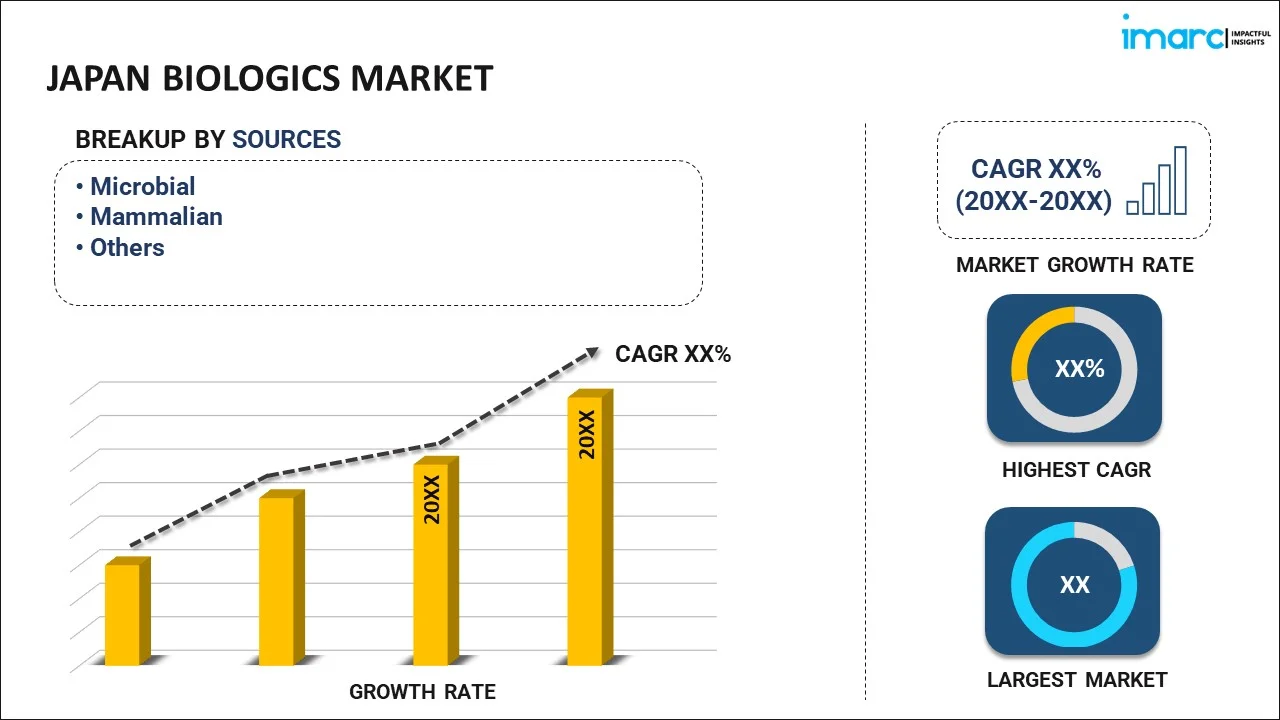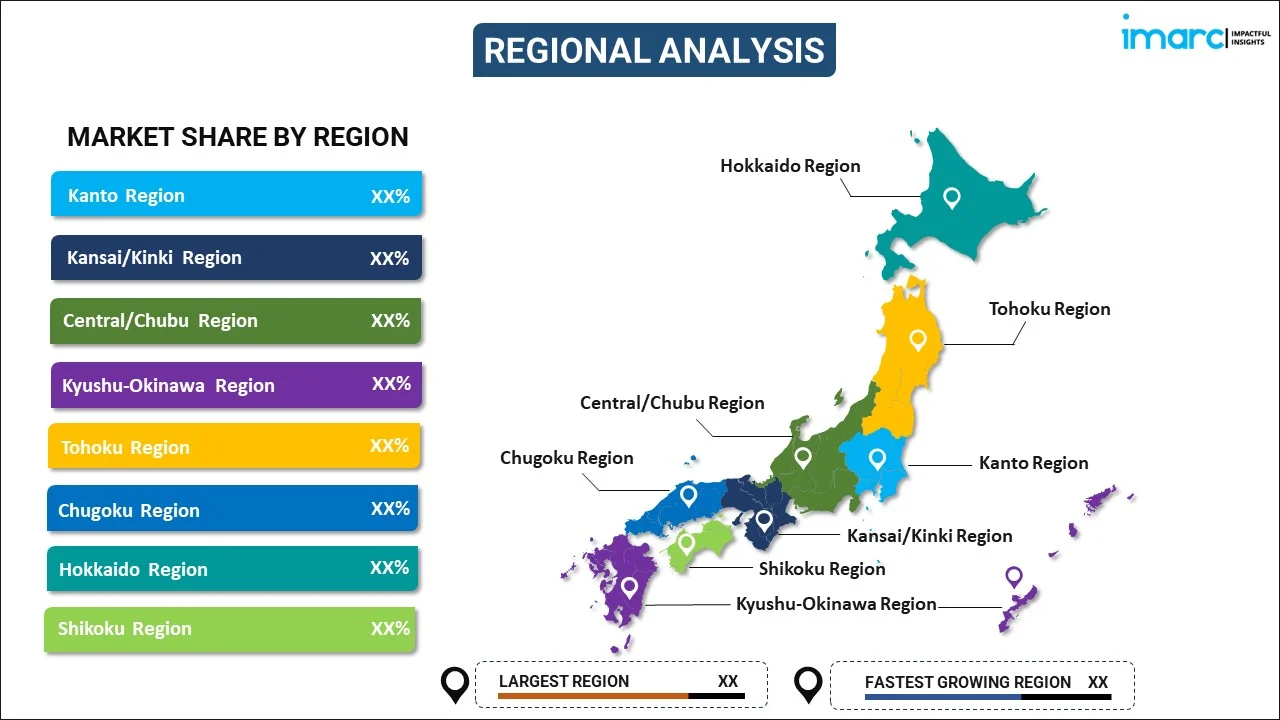
Japan Biologics Market Report by Source (Microbial, Mammalian, and Others), Product (Monoclonal Antibodies, Vaccines, Recombinant Proteins, Antisense, RNAi and Molecular Therapy, and Others), Disease (Oncology, Immunological Disorders, Cardiovascular Disorders, Hematological Disorders, and Others), Manufacturing (Outsourced, In-House), and Region 2025-2033
Market Overview:
Japan biologics market size reached USD 54.5 Billion in 2024. Looking forward, IMARC Group expects the market to reach USD 161.1 Billion by 2033, exhibiting a growth rate (CAGR) of 12.16% during 2025-2033. The growing demand for precision medicine approaches, increasing focus on treating rare diseases, and rising prevalence of chronic and complex diseases, such as cancer, rheumatoid arthritis, multiple sclerosis, and chronic inflammatory conditions, represent some of the key factors driving the market.
|
Report Attribute
|
Key Statistics
|
|---|---|
|
Base Year
|
2024
|
|
Forecast Years
|
2025-2033
|
|
Historical Years
|
2019-2024
|
|
Market Size in 2024
|
USD 54.5 Billion |
|
Market Forecast in 2033
|
USD 161.1 Billion |
| Market Growth Rate 2025-2033 | 12.16% |
Biologics comprise a wide range of pharmaceuticals, including monoclonal antibodies, vaccines, gene therapies, and cell-based therapies. They are derived from living organisms or their components, such as cells, proteins, genes, or tissues. They are produced through biotechnological methods, unlike traditional chemical-based drugs that are synthesized through chemical processes. They interact with specific targets in the body to achieve therapeutic effects. They are known for their high specificity and efficacy, often resulting in fewer side effects compared to conventional drugs. They stimulate the immune system to produce an immune response without causing the disease itself, helping to protect individuals from various viruses and bacteria. They can be tailored to specific genetic or molecular characteristics of disease of patient, enabling personalized treatment approaches. They promote tissue regeneration and wound healing and have fewer side-effects as compared to traditional chemical drugs. They aid in treating certain types of cancer by enhancing the immune response of the body against cancer cells. They assist in addressing rare diseases and orphan diseases that affect a small population. They are used to treat, prevent, or manage various medical conditions and diseases. As they improve the quality of life for patients by effectively managing symptoms and slowing disease progression, the demand for biologics is rising in Japan.
Japan Biologics Market Trends:
At present, the increasing prevalence of chronic and complex diseases, such as cancer, rheumatoid arthritis, multiple sclerosis, and chronic inflammatory conditions, among individuals represents one of the major factors contributing to the market growth in Japan. Moreover, the rising usage of biologics, as they reduce the frequency and severity of hospitalizations, is strengthening the growth of the market in the country. Apart from this, the escalating demand for precision medicine approaches is offering a positive market outlook. Additionally, the increasing awareness among patients about the benefits of biologics, such as fewer side effects, reduced hospital stays, and long-lasting therapeutic effects, is providing lucrative growth opportunities to industry investors in Japan. In line with this, the growing demand for immunotherapies and monoclonal antibodies for treating cancer is influencing the market positively. In addition, innovations in bioproduction methods benefit in cost-effective and efficient production of biologics, which is bolstering the growth of the market. Besides this, the rising number of clinical trials for biologics in the country is propelling the market growth. Furthermore, the increasing focus on treating rare diseases among the masses is impelling the market growth. The technological advancement in biotechnology and genomics enhances the discovery and development of novel biologics, which is also supporting the market growth in Japan.
Japan Biologics Market Segmentation:
IMARC Group provides an analysis of the key trends in each segment of the market, along with forecasts at the country level for 2025-2033. Our report has categorized the market based on source, product, disease, and manufacturing.
Source Insights:

- Microbial
- Mammalian
- Others
The report has provided a detailed breakup and analysis of the market based on the source. This includes microbial, mammalian, and others.
Product Insights:
- Monoclonal Antibodies
- Vaccines
- Recombinant Proteins
- Antisense, RNAi and Molecular Therapy
- Others
A detailed breakup and analysis of the market based on the product have also been provided in the report. This includes monoclonal antibodies, vaccines, recombinant proteins, antisense, RNAi and molecular therapy, and others.
Disease Insights:
- Oncology
- Immunological Disorders
- Cardiovascular Disorders
- Hematological Disorders
- Others
The report has provided a detailed breakup and analysis of the market based on the disease. This includes oncology, immunological disorders, cardiovascular disorders, hematological disorders, and others.
Manufacturing Insights:
- Outsourced
- In-House
A detailed breakup and analysis of the market based on the manufacturing have also been provided in the report. This includes outsourced and in-house.
Regional Insights:

- Kanto Region
- Kansai/Kinki Region
- Central/ Chubu Region
- Kyushu-Okinawa Region
- Tohoku Region
- Chugoku Region
- Hokkaido Region
- Shikoku Region
The report has also provided a comprehensive analysis of all the major regional markets, which include Kanto Region, Kansai/Kinki Region, Central/ Chubu Region, Kyushu-Okinawa Region, Tohoku Region, Chugoku Region, Hokkaido Region, and Shikoku Region.
Competitive Landscape:
The market research report has also provided a comprehensive analysis of the competitive landscape. Competitive analysis such as market structure, key player positioning, top winning strategies, competitive dashboard, and company evaluation quadrant has been covered in the report. Also, detailed profiles of all major companies have been provided.
Japan Biologics Market Report Coverage:
| Report Features | Details |
|---|---|
| Base Year of the Analysis | 2024 |
| Historical Period | 2019-2024 |
| Forecast Period | 2025-2033 |
| Units | Billion USD |
| Scope of the Report | Exploration of Historical Trends and Market Outlook, Industry Catalysts and Challenges, Segment-Wise Historical and Future Market Assessment:
|
| Sources Covered | Microbial, Mammalian, Others |
| Products Covered | Monoclonal Antibodies, Vaccines, Recombinant Proteins, Antisense, RNAi and Molecular Therapy, Others |
| Diseases Covered | Oncology, Immunological Disorders, Cardiovascular Disorders, Hematological Disorders, Others |
| Manufacturings Covered | Outsourced, In-House |
| Regions Covered | Kanto Region, Kansai/Kinki Region, Central/ Chubu Region, Kyushu-Okinawa Region, Tohoku Region, Chugoku Region, Hokkaido Region, Shikoku Region |
| Customization Scope | 10% Free Customization |
| Post-Sale Analyst Support | 10-12 Weeks |
| Delivery Format | PDF and Excel through Email (We can also provide the editable version of the report in PPT/Word format on special request) |
Key Questions Answered in This Report:
- How has the Japan biologics market performed so far and how will it perform in the coming years?
- What has been the impact of COVID-19 on the Japan biologics market?
- What is the breakup of the Japan biologics market on the basis of source?
- What is the breakup of the Japan biologics market on the basis of product?
- What is the breakup of the Japan biologics market on the basis of disease?
- What is the breakup of the Japan biologics market on the basis of manufacturing?
- What are the various stages in the value chain of the Japan biologics market?
- What are the key driving factors and challenges in the Japan biologics?
- What is the structure of the Japan biologics market and who are the key players?
- What is the degree of competition in the Japan biologics market?
Key Benefits for Stakeholders:
- IMARC’s industry report offers a comprehensive quantitative analysis of various market segments, historical and current market trends, market forecasts, and dynamics of the Japan biologics market from 2019-2033.
- The research report provides the latest information on the market drivers, challenges, and opportunities in the Japan biologics market.
- Porter's five forces analysis assist stakeholders in assessing the impact of new entrants, competitive rivalry, supplier power, buyer power, and the threat of substitution. It helps stakeholders to analyze the level of competition within the Japan biologics industry and its attractiveness.
- Competitive landscape allows stakeholders to understand their competitive environment and provides an insight into the current positions of key players in the market.
Need more help?
- Speak to our experienced analysts for insights on the current market scenarios.
- Include additional segments and countries to customize the report as per your requirement.
- Gain an unparalleled competitive advantage in your domain by understanding how to utilize the report and positively impacting your operations and revenue.
- For further assistance, please connect with our analysts.
 Inquire Before Buying
Inquire Before Buying
 Speak to an Analyst
Speak to an Analyst
 Request Brochure
Request Brochure
 Request Customization
Request Customization




.webp)




.webp)












